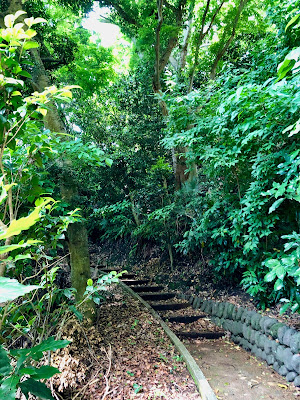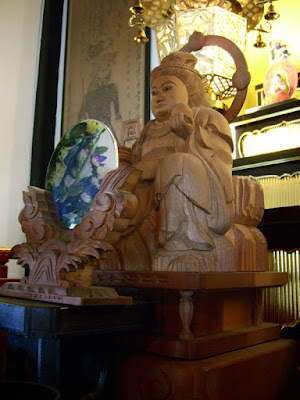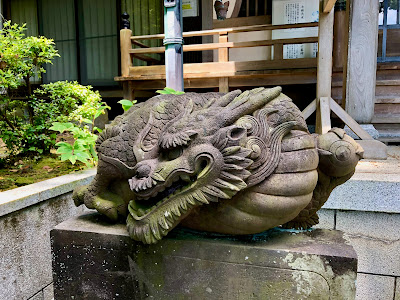目次 / Contents
1) 複数 / Plural
2) わくわく / Be Excited
3) 仏舎利塔 / Stupa
A. 藤井 日達 / Fujii Nichidatsu
B. 景色 / Scenery
4) 五重塔へ / To Five-storied Pagoda
1) 複数 / Plural
1337年に創建され、1886年まで専従の住職を置かずに、
'龍口寺輪番八ヶ寺' (リュウコウジリンバンハチガデラ)
と称される寺院が順番に維持してきました。
この体制を輪番制といい、マンションの管理組合や地域の自治会などでの役員選出でもよく使われ、仏教用語ではありません。
下記、龍口寺輪番八ヶ寺について、Wikiより。
"龍口寺輪番八ヶ寺とは龍口寺を輪番で護持した片瀬・腰越に点在
する8つの寺院。
いずれも山号を龍口山という。
この8ヶ寺はそれぞれが日蓮宗内の主要門流を代表しており、宗門全体で龍口寺を護持するという意義を有する"
8つの寺は、
龍口山本蓮寺 (リュウコウザン ホウレンジ)
龍口山常立寺 (リュウコウザン ジョウリュウジ)
龍口山勧行寺 (リュウコウザン カンギョウジ)
龍口山本成寺 (リュウコウザン ホンジョウジ)
龍口山妙典寺 (リュウコウザン ミョウテンジ)
龍口山本龍寺 (リュウコウザン ホンリュウジ)
龍口山法源寺 (リュウコウザン ホウゲンジ)
龍口山東漸寺(リュウコウザン トウゼンジ)
です。
私は、輪番制は、十三人の合議制 (ジュウサンニンノゴウギセイ) を思い起こし、さらにNHK大河ドラマ
『鎌倉殿の13人』(カマクラドノノ13ニン) を思い起こします。
本日、私と夫Rは、腰越の 'Art & Dining Spaceたぶのき' で開催されている絵本原画展が目的で外出しましたが、近くに、龍口寺 : ★が
あるので、見学しにゆきました。
私たちは、以前、少なくとも2回は、このお寺を訪れていましたが、Rは覚えていませんでした。
なので、彼の記憶を喚起するためにも足を運びました。
本日、私と夫Rは、腰越の 'Art & Dining Spaceたぶのき' で開催されている絵本原画展が目的で外出しましたが、近くに、龍口寺 : ★が
あるので、見学しにゆきました。
私たちは、以前、少なくとも2回は、このお寺を訪れていましたが、Rは覚えていませんでした。
なので、彼の記憶を喚起するためにも足を運びました。
本堂、五重塔、、七面堂 (シメンドウ)、仏舎利塔 (ブッシャリトウ) などがあります。
各建物について、それぞれのセクションで書いています。
このセクションは、主に仏舎利塔についてです。
仁王門と龍ノ口刑場跡 については下記。
本殿周辺については下記。
七面堂については下記。
⑤ 2022年5月23日 龍口寺 ・七面堂 / Shichimen-do Hall in Ryūkō...
 |
龍口寺境内 仏舎利塔は左上です。 Ryūkō-ji Temple Precincts in Japanese The stupa is on the upper left. 画像は下記より / This from below |
Plural
Ryūkō-ji Temple (龍口寺) is located in Katase, Fujisawa City,
Kanagawa Prefecture and is a temple of the Nichiren Shū (Nichiren School / Nichiren sect) .
Founded in 1337, the temple was maintained in turn without a full-time chief priest until 1886, called 'Ryūkōji Rinban Hachi-ga-dera (8 Temples)'.
This system is called a rotation system, and it is often used in the election of officers by condominium management associations and local residents' associations, and is not a Buddhist term.
According to Japanese Wiki about 'Ryūkōji Rinban Hachi-ga-dera'.
(Translated by me)
" 'Ryūkōji Rinban Hachi-ga-dera' means the eight temples scattered in Katase and Koshigoe that protect Ryūkō-ji Temple in rotation.
Sangō of all temples is Ryūkōzan .
Each of these eight temples represents a major school within the Nichiren Shū, and the entire sect has the significance of protecting Ryūkō-ji Temple."
The eight temples are below.
Ryūkōzan Hōren-ji Temple
Ryūkōzan Kangyo-ji Temple
Ryūkōzan Honjō-ji Temple
Ryūkōzan Myōten-ji Temple
Ryūkōzan Honryu-ji Temple
Ryūkōzan Hōgen-ji Temple
Ryūkōzan Tōzen-ji Temple
The Rinban system reminds me of 'Jyusan-nin no Gougisei' : the 13-person council system ; an advisory council formed with thirteen members and also the NHK Taiga drama "The 13 Lords of the Shogun" (鎌倉殿の13人, Kamakura-dono no Jūsan-nin) .
Today, I and my husband R went out for the purpose of the picture book original painting exhibition held in 'Art & Dining Space Tabunoki' in Koshigoe, Kamakura, Kanagawa prefecture, though we visited the Ryūkō-ji Temple, because the venue is near.
We had visited this temple at least twice before, but R could not remember.
So we went there to reawaken his memory as well.
In the precincts, there are the Tatsunokuchi Persecution site, main hall, Japanese Five-storied Pagota, Shichimen-do Hall, stupa, etc.
This section is primarily about stupa.
About Niōmon Gate and Tatsunokuchi execution site, below.
About the Main Hall, below.
About Shichimen-do Hall, below.
 |
龍口寺境内 (Google Map) 仏舎利塔は左上です。 左下に江ノ電の線路があります。 地図南方面に相模湾があります。 Ryūkō-ji Temple Precincts in Japanese The stupa is on the upper left. Sagami Bay is located in the southern part of the map. 画像は下記より / This from below |
 |
| 龍口寺前を走る江ノ電。 The Enoden train runs in front of Ryūkō-ji Temple. |
2) わくわく / Be Excited
 |
| 登る 七面堂まで登り、仏舎利塔をめざして、さらにまた登ります。 この登り道は、山中を歩く感じがし、 わくわく感があり、とても楽しいです。 山の中や丘上にある寺院や神社をめざすときは 登りが苦行に感じる場合が多々あります。 ですがここは違います。 少なくとも私にとっては...。 Climb Climb up to Shichimen-do Hall, aim for the stupa, and climb again. This climbing path feels like walking in the mountains, and it is exciting and fun. When visiting temples and shrines in mountains or on hills, climbing can often feel like an ordeal. But not here. At least for me... |
 |
| 山を感じさせる木々 Trees that make me feel the mountain |
 |
| 木々の緑が綺麗、合間に青空が見えます。 The green of the trees is beautiful, and you can see the blue sky in between. |
 |
| 仏舎利塔の頂点部分が見えます。 I can see the top part of the stupa. |
 |
| 江ノ島が見えます。 高い建物群がなかった昔は、絶景だったでしょう。 I can see Enoshima Island. In the past, when there were no tall buildings, it would have been a spectacular view.  |
写真には撮れませんでしたが、下を見ると江ノ電が走っているところも見えました。
そのシーンもなかなか楽しいものでした。
I couldn't take a picture, but when I looked down, I could see the Enoden train running.
That scene was pretty fun too.
 |
| 木々の間から相模の海が見えます。 I can see the sea of Sagami through the trees. |
 |
人工的な何かがあります。 現代アート作品のようです。 There is something artificial. It looks like a contemporary art work. |
 |
仏舎利塔を作ったときに使用したトロッコの跡か と推測します。 I guess it is the remains of the trolley track used when the stupa was built. |
 |
| 仏舎利塔に到着! Arrive at the Stupa! |
A. 藤井 日達 / Fujii Nichidatsu
龍口寺の仏舎利塔は、1970年、
龍ノ口法難 (タツノクチホウナン/ 1271)、700年を記念し、
藤井 日達 (フジイ ニッタツ又はフジイニチダツ/ 1885 - 1985) が建立しました。
法華経を通して世界平和実現を理想とし、日本および世界各地に仏舎利等を建てました。
1957年には、ネルー首相 (1889 -1964) と会見しています。
 |
| 異国、インドの雰囲気です。 仏舎利塔は通常仏塔の原型であるインドの ストゥーパの様式が用いられるようなので、 そう私が感じるのは最もなことです。 I feel it is a foreign country, with the atmosphere of India. Indeed, I can think this, as stupas usually seem to use the style of the stupa in India, which is the origin of stupa. |
Fujii Nichidatsu
The stupa of Ryūkō-ji Temple was built in 1970 by Nittatsu Fujii or Nichidatsu Fujii (1885 - 1985) to commemorate the 700th anniversary of the Tatsunokuchi Persecution in 1271.
Fujii Nichidatsu studied various religions and founded the Nipponzan-myohoji-daisanga) of the Hokke sect.
He idealized the realization of world peace through the Lotus Sutra, and built stupas in Japan and around the world.
In 1933 Fujii Nichidatsu met with Mahatma Gandhi (1869 - 1948) in 1933 and resonated with Gandhi's advocacy of Nonviolence.
In 1957 he met with a Prime Minister, Jawaharlal Nehru (1889 - 1964).
 |
| 説明板によると、この仏舎利塔には、 ネルー首相より贈られた仏舎利が 納められています。 According to the information board, this stupa contains Busshari : Buddha's ashes donated by Jawaharlal Nehru. |
 |
| 複数のペットのお墓、 または卒塔婆 (ソトバ / 板塔婆 : イタトウバ) です。 びっくりです! Multiple pet grave or sotoba : wooden stupas. I was surprised!  |
B.景色 / Scenery
 |
| 仏舎利塔の階段を登ると、相模湾の景色が より一層高く眺めることができます。 If you climb the steps of the stupa, you can see the scenery of Sagami Bay from even higher up. |
4) 五重塔へ / To Five-storied Pagoda
仏舎利塔を離れて、五重塔へむかいます。
Leave the stupa and head for the five-storied pagoda.
 |
| 山から降ります。 登った時と違う道を使いました。 Descend from the Mountain. We used a different route than when we climbed. |
 |
| 手すりにリス! A Squirrel on the Railing! |
 |
| 木々の形を楽しみながら降りてゆきました。 I descended while enjoying the shapes of the trees. 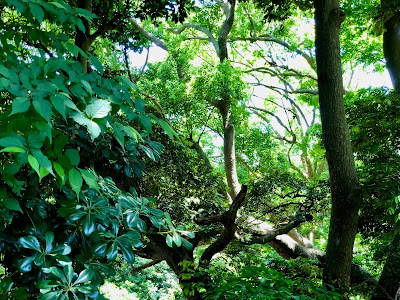 |
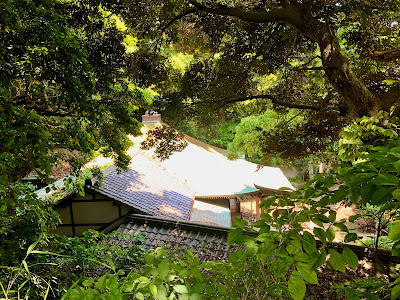 |
| 七面堂の屋根 Shichimen-do Hall Roof |
 |
| 登りは、あちらの階段を利用しました。 When we climbed, we used the steps over there. |
 |
| 木漏れ日が作る形が梅の花のようです。 The shape of the sunlight filtering through the foliage looks like a plum blossom. |
 |
綺麗です! / Beautiful! |





